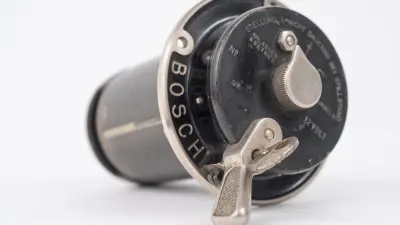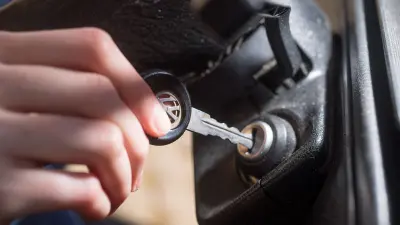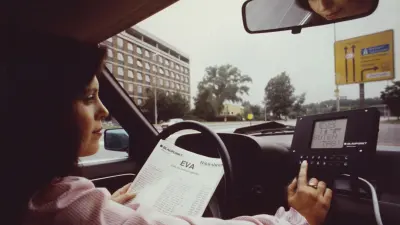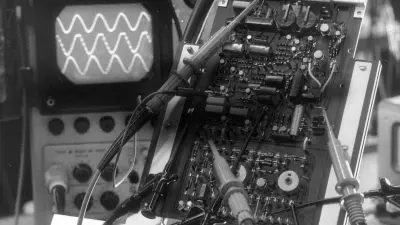From car keys to perfectly keyless. Over 100 years of Bosch car locking technology

Did the first motor carriages actually have locks? How did motorists in the last century prevent their vehicles from being stolen? It’s a long story. It tells of how theft protection first became necessary when people who were previously unfamiliar with cars learned how to start them in the first place. It also illustrates that people could only safely leave their valuables in the car when it had lockable doors, windows, and a roof. Even in times of keyless and remote locking, protecting cars and their contents from thieves remains a challenge to this day. As an international technology leader, Bosch is constantly setting standards.
Driving a car today involves opening the door by pressing a remote control, and then starting by pushing a button. Some cars even unlock their own doors as their owners approach.
To do so, a card in the owner’s pocket or purse sends a signal to a receiver in the vehicle to prove that the approaching person owns the car and is allowed to access it. Once inside, all the driver needs to do is press the start button.
Only drivers of classic cars still use a physical key to open the door lock and unlock the driver’s side door — and the driver’s side door only — before sticking a second key in the ignition.
The first cars needed no protection
The need to protect cars from theft and burglary has been around for a long time, but not quite for as long as the automobile. Bosch equipped even the first roadworthy automobiles featuring combustion engines with the necessary ignition systems. Often, the vehicles also had a separate rotary switch to close the electric circuit before driving off. Once the ignition circuit was closed and the car ready to go, the driver had to get out and turn the crank at the front of the vehicle.

Car theft impossible thanks to lockable ignition coil
There was no need for protection against theft through the use of an ignition key instead of a rotary switch. Around 1900, starting a car was a rather complex undertaking involving some ten steps that only properly trained drivers could master. As a result, car theft was not an issue, and theft deterrence was not on the agenda of automakers and suppliers such as Bosch. Later, however, these rotary ignition switches would become the foundation of protecting cars from theft – provided it was possible to lock the switches. Once the switch was set to the off position and the flow of current interrupted, only the owner of the key could have turned it back on again, making it impossible for unauthorized persons to drive off with the car.

Bosch's first car locking system

In 1911, Bosch started supplying ignition switches requiring a key. Drivers had to stick the key in the ignition switch and turn it to the on position. Without this tiny, unspectacular-looking key in the lock, it was impossible to turn the ignition knob. This was the beginning of theft deterrence systems. Since then, they have evolved from ignition switches and locking every door on a car to keyless systems in the beginning of the 21st century — and now to Bosch’s Perfectly Keyless that works via Smartphone on a high security level.
Protecting cars from people who want to break into cars and rob their content without stealing them is a central aspect of automotive locking systems. A century ago, that was not the case. Until around 1920, early automobiles were open, making it useless to lock a door. In fact, some did not even have any doors.
Greater safety and comfort: Locking cars is gaining ground
Locking cars did not enter the picture until automobiles with canopy tops, doors, and closed roofs became popular in the 1920s. The new trends offered a practical deterrent against vandalism and theft. Drivers could safely leave objects lying in their cars — unless criminals were willing to resort to breaking windows. The combination of deactivating the ignition, and later the entire on-board electrical system, and locking the interior of the car was conceived some 80 years ago and remains common practice to this day.

One for all — the combined door and ignition key
Until the 1960s, some cars still had different keys for the doors and the ignition. A combined key for all purposes, the precursor of today’s locking systems, gained popularity as the decade wore on. Drivers used the key to start the car by briefly but forcefully turning it clockwise in the ignition. Over the past ten years, however, the advent of Keyless Go systems has meant the reintroduction of a separate start button in cars — something drivers were already familiar with back in the 1920s. Still, they could hardly have imagined that a century later, their descendants would be able to open car doors wirelessly.

Key and start button go digital
And so it is with the Perfectly keyless app: sensors inside the car detect the driver’s smartphone as the driver approaches the car. Once this happens, the system opens the car without the driver having to find their keys, starts up the engine, and closes it again when the journey is finished. Then, another key is sent via the cloud to other smartphones in a secure process that is protected from access by unauthorized parties. In this way, sharing providers and fleet operators can flexibly manage who accesses their vehicles and when.
Author: Dietrich Kuhlgatz


